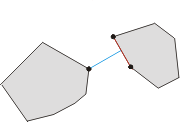| Time Limit: 1000MS | Memory Limit: 65536K | |||
| Total Submissions: 11607 | Accepted: 3419 | Special Judge | ||
Description
Thousands of thousands years ago there was a small kingdom located in the middle of the Pacific Ocean. The territory of the kingdom consists two separated islands. Due to the impact of the ocean current, the shapes of both the islands became convex polygons. The king of the kingdom wanted to establish a bridge to connect the two islands. To minimize the cost, the king asked you, the bishop, to find the minimal distance between the boundaries of the two islands.

Input
The input consists of several test cases.
Each test case begins with two integers N, M. (3 ≤ N, M ≤ 10000)
Each of the next N lines contains a pair of coordinates, which describes the position of a vertex in one convex polygon.
Each of the next M lines contains a pair of coordinates, which describes the position of a vertex in the other convex polygon.
A line with N = M = 0 indicates the end of input.
The coordinates are within the range [-10000, 10000].
Output
For each test case output the minimal distance. An error within 0.001 is acceptable.
Sample Input
4 4 0.00000 0.00000 0.00000 1.00000 1.00000 1.00000 1.00000 0.00000 2.00000 0.00000 2.00000 1.00000 3.00000 1.00000 3.00000 0.00000 0 0
Sample Output
1.00000
Source
POJ Founder Monthly Contest – 2008.06.29, Lei Tao
大致题意:
给你两个凸多边形,求这两个凸多边形间最小距离。
题解:
AC代码:
#include<cstdio>
#include<iostream>
#include<algorithm>
#include<cmath>
#define eps 1e-10
using namespace std;
const int Maxn=100005;
struct node{
double x,y;
}a1[Maxn],ans1[Maxn],a2[Maxn],ans2[Maxn];
double ojbk[Maxn];
int n,sum1,sum2,cnt,m;
bool cmp(node x,node y){
if(x.y!=y.y)return x.y<y.y;
return x.x<y.x;
}
node operator -(const node &x,const node &y){
node c;
c.x=x.x-y.x;c.y=x.y-y.y;
return c;
}
inline double cro(node o,node x,node y){
x=x-o;y=y-o;
return x.x*y.y-x.y*y.x;
}
inline double dot(node o,node x,node y){
x=x-o;y=y-o;
return x.x*y.x+x.y*y.y;
}
inline double f(double x){
return x*x;
}
inline double dis(node x,node y){
return sqrt((x.x-y.x)*(x.x-y.x)+(x.y-y.y)*(x.y-y.y));
}
void convex1(){
sort(a1+1,a1+1+n,cmp);
for(int i=1;i<=n;i++){
while(sum1>=2&&cro(ans1[sum1-1],ans1[sum1],a1[i])<=0){
sum1--;
}
ans1[++sum1]=a1[i];
}
int lim=sum1;
for(int i=n;i>=1;i--){
while(sum1>=lim+1&&cro(ans1[sum1-1],ans1[sum1],a1[i])<=0){
sum1--;
}
ans1[++sum1]=a1[i];
}
sum1--;
}
void convex2(){
sort(a2+1,a2+1+m,cmp);
for(int i=1;i<=m;i++){
while(sum2>=2&&cro(ans2[sum2-1],ans2[sum2],a2[i])<=0){
sum2--;
}
ans2[++sum2]=a2[i];
}
int lim=sum2;
for(int i=m;i>=1;i--){
while(sum2>=lim+1&&cro(ans2[sum2-1],ans2[sum2],a2[i])<=0){
sum2--;
}
ans2[++sum2]=a2[i];
}
sum2--;
}
double mn(double x,double y){
return x<y?x:y;
}
inline int add1(int x,int y){
x+=y;
x%=n+1;
if(x==0)x=1;
return x;
}
inline int add2(int x,int y){
x+=y;
x%=m+1;
if(x==0)x=1;
return x;
}
inline double ab(double x){
return x>0?x:-x;
}
inline double disp(node x,node y,node z){
if(dis(x,y)<eps)return dis(x,z);
if(dot(x,y,z)<-eps)return dis(x,z);
if(dot(y,x,z)<-eps)return dis(y,z);
return ab(cro(x,y,z)/dis(x,y));
}
inline double dist(node x1,node x2,node y1,node y2){
double ansx;
ansx=mn(mn(disp(x1,x2,y1),disp(x1,x2,y2)),mn(disp(y1,y2,x1),disp(y1,y2,x2)));
return ansx;
}
void work(){
double maxy=0,ansn=100000001,tmp;
int i,j,nxi,nxj;
for(int i=1;i<=n;i++){
cin>>a1[i].x>>a1[i].y;
}
for(int i=1;i<=m;i++){
cin>>a2[i].x>>a2[i].y;
}
sum1=sum2=0;
convex1();
convex2();
n=sum1;m=sum2;
for(int i=1;i<=m;i++){
if(maxy<a2[i].y){
maxy=a2[i].y;
j=i;
}
}
ans1[n+1]=ans1[1];
ans2[m+1]=ans2[1];
i=1;
for(int p=1;p<=n;p++){
nxi=add1(i,1);
nxj=add2(j,1);
while(cro(ans2[j],ans2[nxj],ans1[nxi])>cro(ans2[j],ans2[nxj],ans1[i])){
i=nxi;
nxi=add1(i,1);
}
ansn=mn(ansn,dist(ans1[i],ans1[nxi],ans2[j],ans2[nxj]));
j=nxj;
}
printf("%.5lf\n",ansn);
}
int main(){
while(1){
scanf("%d%d",&n,&m);
if(n==0)return 0;
work();
}
return 0;
}


